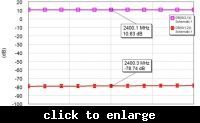afz23
Full Member level 3
This post was by mistake posted in wrong forum,I am re-posting it here:
I have found out experimentally,I need an isolation of better than 80dB between VCO
and mixer/modulator to avoid VCO frequency pulling to a great extent.
Is there a simple mathematical equation to find out before hand the isolation value required ?
I have found out experimentally,I need an isolation of better than 80dB between VCO
and mixer/modulator to avoid VCO frequency pulling to a great extent.
Is there a simple mathematical equation to find out before hand the isolation value required ?
